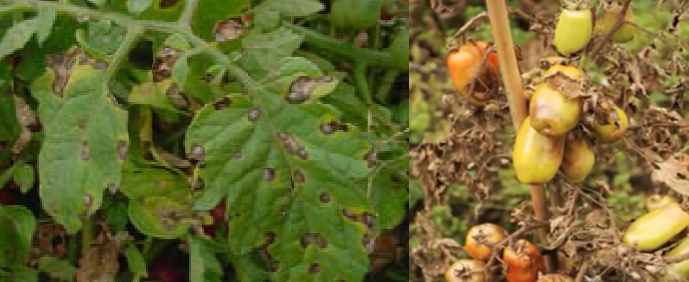
The tissue surrounding the initial lesion may become yellow, and when lesions are numerous entire leaves may become chlorotic. It first appears as small brown to black lesions on older foliage. Early blight ( Alternaria solani)Įarly blight occurs on the foliage, stem, and fruit of tomato and also occurs worldwide. Once introduced, Septoria is spread by splashing water, insects, workers, and equipment. The pathogen overwinters on infected tomato debris or infected solanaceous weed hosts, and can also survive on stakes and other equipment. The fruiting bodies, smaller lesion size, and associated yellowing of heavily infected foliage help to distinguish this disease from late blight.įruit infection is rare, but lesions occur on foliage, stems, petioles, and the calyx.
#LATE BLIGHT IN TOMATOES PLUS#
These fruiting bodies, plus the generally smaller size of the lesions, and the absence of target-like circular bands within the lesion distinguish this disease from early blight. With a 10X hand lens, these black specks can be seen in the center of the lesions. If conditions are favorable, lesions can enlarge rapidly, form pycnidia (fruiting bodies that look like black specks) and turn infected leaves yellow then brown. Symptoms consist of circular tan to grey lesions with a dark brown margin that appear on lower leaves first, after the first fruit set. Once infections begin, they can spread rapidly from lower to upper tomato canopy. This disease can destroy most of a plant’s foliage resulting in sunscald,failure of fruit to mature properly, and low yields. Septoria leaf spot is one of the most destructive diseases of tomato foliage and it occurs worldwide wherever tomatoes are grown. Septoria leaf spot ( Septoria lycopersici) If the lesion has a yellow border and is occurring on the bottom of the plant, it is likely due to infection of either early blight or Septoria leaf spot. Firm, brown spots develop on tomato fruit. These stem lesions are a fairly distinctive sign of late blight and should definitely raise a red flag. Brown to blackish lesions develop on upper stems and leaf petioles. Leaf lesions begin as tiny, irregularly shaped brown spots and quickly grow larger – spots that are consistently small are most likely septoria leaf spot (see below). Sometimes the lesion border is slightly yellow or has a water-soaked appearance (see image). See Recognizing Tomato Blights for images.Ĭlassic symptoms are large (at least nickel-sized) olive-green to brown spots on leaves with slightly fuzzy white fungal growth on the underside when conditions have been humid (early morning or after rain). The most common symptoms on tomatoes are sunken, dark green or brown lesions on leaves and brown lesions on stems, with white fungal growth developing under moist conditions.

We’re also trying to assess the presence of the pathogen by scouting fields, analyzing samples that come into the disease lab, and trying to catch the leading edge of the disease development here in Massachusetts.
#LATE BLIGHT IN TOMATOES UPDATE#
We’re tracking the weather conditions as well as we’re able – see the update on disease forecasting in this issue of Vegetable Notes. Assessing the risk for this season depends on those two things – favorable weather conditions and the presence of the pathogen. Spores survive up to one hour in sunny, dry conditions, and up to 4 hrs in cloudy weather. Favorable conditions for sporulation and areal dispersal are leaf wetness for more than 10 to 12 hours at moderate temperatures 60°-70☏. The 2009 growing season combined highly favorable weather for the disease (cool and moist) with numerous points of inoculation. This explosive growth is what devastated tomato and potato crops in 2009. The danger with this disease is that, under the right weather conditions, the development and spread of the pathogen can be explosive. Late Blight (Phytophthora infestans)Įffective management of this disease is largely dependent on an accurate assessment of risk, and knowing where and when the disease is present is a key component in assessing the risk to your crops. While it’s impossible to determine which pathogen is causing leaf symptoms without a lab confirmation, the information in this article may help you to distinguish a possible late blight infection from some of the other common blights. In any year, early detection and management of late blight is a key factor in minimizing the risk of an epidemic. The 2009 growing season was an excellent example of how bad the disease can be.

Given the right weather conditions and an early initial infection, late blight can be a devestating disease on tomato and potato crops.


 0 kommentar(er)
0 kommentar(er)
